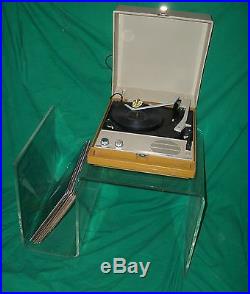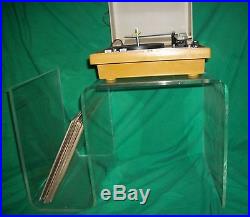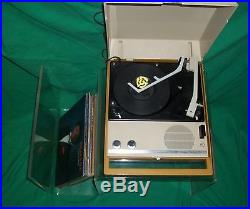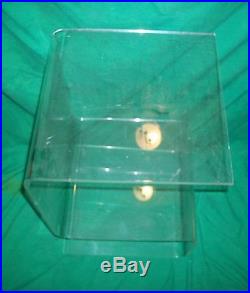Vtg Estate Lucite S Table Retro MID Century Modern Record Player Rack Stand Pop









VTG ESTATE LUCITE S TABLE RETRO MID CENTURY MODERN RECORD PLAYER RACK STAND POP! We welcome any comments, questions, or concerns. WE ARE TARGETING A GLOBAL MARKET PLACE. Thanks in advance for your patronage.
Please Be sure to add WDG to your. NOW FOR YOUR VIEWING PLEASURE. MID CENTURY MODERN POPULAR CULTURE HOME FURNINSHING ACRYLIC LUCITE TABLE "S" FORM FOR RECORD PLAYER & RECORDS. MEASURES ABOUT 24" LONG 16" WIDE by 16 HIGH USED / SOME SURFACE WEAR / SCRATCHES from AGE CIRCA 1965 MAKER - UNKNOWN. & RECORDS ARE NOT INCLUDED! The phonograph record player, or gramophone (letter + sound) is a device introduced in 1877 that continued common use until the 1980s for reproducing (playing) sound recordings, although when first developed, the phonograph was used to both record and reproduce sounds. The recordings played on such a device generally consist of wavy lines that are either scratched, engraved, or grooved onto a rotating cylinder or disc.As the cylinder or disc rotates, a needle or other similar object on the device traces the wavy lines and vibrates, reproducing sound waves. The phonograph was invented in 1877 by Thomas Alva Edison at his laboratory in Menlo Park, New Jersey, USA. On February 19, 1878, Edison was issued the first patent U.
Patent #200,521 for the phonograph. While other inventors had produced devices that could record sounds, Edison's phonograph was the first to be able to reproduce the recorded sound. In announcing the demonstration, Scientific American noted that the non-reproducing devices that preceded Edison's had been built by Marey and Rosapelly, Édouard-Léon Scott de Martinville and Barlow. Although Edison began experimenting on the Phonograph using wax coated paper as a recording medium, this first Phonograph recorded sound onto a tinfoil sheet phonograph cylinder.
Alexander Graham Bell's Volta Laboratory made several improvements in the 1880s, including the use of wax-coated cardboard cylinders, and a cutting stylus that moved from side to side in a "zig zag" pattern across the record. Then at the turn of the century, Emile Berliner initiated the transition from phonograph cylinders to gramophone records: flat, double-sided discs with a spiral groove running from the periphery to near the center.
Other improvements were made throughout the years, including modifications to the turntable and its drive system, the needle and stylus, and the sound and equalization systems. The gramophone record was one of the dominant audio recording formats throughout much of the 20th Century. However, that status was eventually replaced by the compact disc and other digital recording formats. Usage of these terms is not uniform across the English-speaking world (see below).
In more modern usage, this device is often called a turntable, record player, or record changer. When used in conjunction with a mixer as part of a DJ set up, they are often called decks. The term phonograph ("sound writer") is derived from the Greek words? (meaning "writing" and transliterated as graphe). Similar related terms gramophone and graphophone have similar root meanings.The coinage, particularly the use of the -graph root, may have been influenced by the then-existing words phonographic and phonography, which referred to a system of phonetic shorthand; in 1852 The New York Times carried an advertisement for "Professor Webster's phonographic class", hjvF. Fenby was the original author of the word.
An inventor in Worcester, Massachusetts, he was granted a patent in 1863 for an unsuccessful device called the "Electro-Magnetic Phonograph". His concept detailed a system that would record a sequence of keyboard strokes onto paper tape. Although no model or workable device was ever made, it is often seen as a link to the concept of punched paper for player piano rolls (1880s), as well as Herman Hollerith's punch card tabulator (used in the 1890 United States census), a distant precursor of the modern computer.Poly(methyl methacrylate) (PMMA) is a transparent thermoplastic, often used as a lightweight or shatter-resistant alternative to glass. Although it is not technically a type of glass, the substance has sometimes historically been called acrylic glass. Chemically, it is the synthetic polymer of methyl methacrylate.
PMMA is an economical alternative to polycarbonate (PC) when extreme strength is not necessary. Additionally, PMMA does not contain the potentially harmful bisphenol-A subunits found in polycarbonate.
The non-modified PMMA behaves in a brittle manner when loaded, especially under an impact force, and is more prone to scratching than conventional inorganic glass. However, the modified PMMA achieves very high scratch and impact resistance. The often-seen[citation needed] spelling poly(methyl 2-methylpropanoate)that is, spelled with an instead of enis a misspelling of poly(methyl 2-methylpropenoate). The first acrylic acid was created in 1843.
Methacrylic acid, derived from acrylic acid, was formulated in 1865. The reaction between methacrylic acid and methanol results in the ester methyl methacrylate.
The German chemists Wilhelm Rudolph Fittig and _____ Paul discovered in 1877 the polymerization process that turns methyl methacrylate into polymethyl methacrylate. In 1933 another German chemist, Otto Röhm, patented and registered the brand name PLEXIGLAS. In 1936 the first commercially viable production of acrylic safety glass began by ICI Acrylics (now Lucite International). During World War II acrylic glass was used for submarine periscopes, windshields, canopies, and gun turrets for airplanes. It is often generically called acrylic glass, although it is chemically unrelated to glass. It is sometimes called simply acrylic, although acrylic can also refer to other polymers or copolymers containing polyacrylonitrile. Other notable trade names include. THIS PICTURE FOR DISPLAY ONLY. DO NOT BE TOO PERSNICKETY. Please leave feedback when you have received the item and are satisfied. Our goal is for 5-star service. We want you to be a satisfied, return customer. Please express any concerns or questions. More pictures are available upon request. Thanks for perusing THIS and ALL our auctions. Please Check out our other items. WE like the curious and odd. Create your brand with Auctiva's. Attention Sellers - Get Templates Image Hosting, Scheduling at Auctiva. The item "VTG ESTATE LUCITE S TABLE RETRO MID CENTURY MODERN RECORD PLAYER RACK STAND POP" is in sale since Saturday, November 11, 2017. This item is in the category "Collectibles\Vintage, Retro, Mid-Century\1960s".The seller is "cbenhob" and is located in Jenks, Oklahoma. This item can be shipped worldwide.
- Country/Region of Manufacture: United States